Electricity Forecasting Improvement in a Destination Using Tourism Indicators
Abstract
1. Introduction
2. Literature Review
3. Data
3.1. Electricity Demand and Their Emissions
3.2. Daily Human Presure Indicator (DHPI)
4. Model Development
4.1. Basic Holt–Winters Methods
4.2. New Holt–Winters with the DHPI Model
5. Results
- two-step process, where both models were fit separately to obtain the parameters. Then, parameters were combined to obtain .
- The DHPI was initially fit, as the electricity demand model requires its error. After obtaining DHPI parameters and error, the complete model is simultaneously adjusted, including .
6. Conclusions and Limitations
Author Contributions
Funding
Acknowledgments
Conflicts of Interest
References
- Gray, R.; Bebbington, J. Accounting for the Environment; Sage Publications: London, UK, 2001; ISBN 9780761971368. [Google Scholar]
- Rubio Gil, M.Á.; Mazón Martínez, T. El capital social como factor coadyuvante de los procesos de desarrollo turístico y socioeconómico de los destinos de interior [Social capital as a contributory factor in the tourism and socioeconomic development processes of interior destinations]. Pap. Tur. 2009, 45, 41–55. [Google Scholar]
- Mason, P. Tourism Impacts, Planning and Management, 3rd ed.; Routledge: London, UK, 2015; ISBN 9781315781068. [Google Scholar]
- Archer, B.; Cooper, C.; Ruhanen, L. The positive and negative impacts of tourism. In Global Tourism; Elsevier Science: Burlington, MA, USA, 2005; pp. 79–102. [Google Scholar]
- Zhang, M.; Li, J.; Pan, B.; Zhang, G. Weekly hotel occupancy forecasting of a tourism destination. Sustainability 2018, 10, 4351. [Google Scholar] [CrossRef]
- Bakhat, M.; Rosselló, J. Estimation of tourism-induced electricity consumption: The case study of Balearics Islands, Spain. Energy Econ. 2011, 33, 437–444. [Google Scholar] [CrossRef]
- Gössling, S. Sustainable Tourism Development in Developing Countries: Some Aspects of Energy Use. J. Sustain. Tour. 2000, 8, 410–425. [Google Scholar] [CrossRef]
- Gössling, S.; Hall, M. An Introduction to Tourism and Global Environmental Change. In Tourism and Global Environmental Change; Routledge: London, UK, 2006; pp. 15–48. ISBN 9780203011911. [Google Scholar]
- Peeters, P.; Schouten, F. Reducing the Ecological Footprint of Inbound Tourism and Transport to Amsterdam. J. Sustain. Tour. 2006, 14, 157–171. [Google Scholar] [CrossRef]
- Scott, D.; Hall, C.M.; Gössling, S. A report on the Paris Climate Change Agreement and its implications for tourism: Why we will always have Paris. J. Sustain. Tour. 2016, 24, 933–948. [Google Scholar] [CrossRef]
- Scott, D.; Hall, C.M.; Gössling, S. A review of the IPCC Fifth Assessment and implications for tourism sector climate resilience and decarbonization. J. Sustain. Tour. 2016, 24, 8–30. [Google Scholar] [CrossRef]
- Scott, D.; Gössling, S.; Hall, C.M.; Peeters, P. Can tourism be part of the decarbonized global economy? The costs and risks of alternate carbon reduction policy pathways. J. Sustain. Tour. 2016, 24, 52–72. [Google Scholar] [CrossRef]
- Becken, S.; Simmons, D.G. Understanding energy consumption patterns of tourist attractions and activities in New Zealand. Tour. Manag. 2002, 23, 343–354. [Google Scholar] [CrossRef]
- Gössling, S. Global environmental consequences of tourism. Glob. Environ. Chang. 2002, 12, 283–302. [Google Scholar] [CrossRef]
- Gössling, S.; Hansson, C.B.; Hörstmeier, O.; Saggel, S. Ecological footprint analysis as a tool to assess tourism sustainability. Ecol. Econ. 2002, 43, 199–211. [Google Scholar] [CrossRef]
- Meng, W.; Xu, L.; Hu, B.; Zhou, J.; Wang, Z. Quantifying direct and indirect carbon dioxide emissions of the Chinese tourism industry. J. Clean. Prod. 2016, 126, 586–594. [Google Scholar] [CrossRef]
- Lee, J.; Brahmasrene, T. Investigating the influence of tourism on economic growth and carbon emissions: Evidence from panel analysis of the European Union. Tour. Manag. 2013, 38, 69–76. [Google Scholar] [CrossRef]
- Paramati, S.R.; Alam, M.S.; Chen, C.-F. The Effects of Tourism on Economic Growth and CO2 Emissions: A Comparison between Developed and Developing Economies. J. Travel Res. 2017, 56, 712–724. [Google Scholar] [CrossRef]
- Rutty, M.; Gössling, S.; Scott, D.; Hall, C.M. The Global Effects and Impacts of Tourism. In The Routledge Handbook of Tourism and Sustainability; Routledge: Abingdon, UK, 2015. [Google Scholar]
- Cárdenas, V.; Rosselló, J. Análisis económico de los impactos del cambio climático en el turismo: Estado de la cuestión [Economic analysis of the impacts of climate change on tourism: State of the art]. Ekonomiaz Revista vasca de Economía 2008, 67, 262–283. [Google Scholar]
- Fortuny, M.; Soler, R.; Cánovas, C.; Sánchez, A. Technical approach for a sustainable tourism development. Case study in the Balearic Islands. J. Clean. Prod. 2008, 16, 860–869. [Google Scholar] [CrossRef]
- Becken, S. Analysing international tourist flows to estimate energy use associated with air travel. J. Sustain. Tour. 2002, 10, 114–131. [Google Scholar] [CrossRef]
- Becken, S.; Simmons, D.G.; Frampton, C. Energy use associated with different travel choices. Tour. Manag. 2003, 24, 267–277. [Google Scholar] [CrossRef]
- Becken, S. Tourism and Transport in New Zealand: Implications for Energy Use. 2001, pp. 1–34. Available online: https://core.ac.uk/download/pdf/35459093.pdf (accessed on 21 January 2019).
- Tabatchnaia-Tamirisa, N.; Loke, M.K.; Leung, P.; Tucker, K.A. Energy and tourism in Hawaii. Ann. Tour. Res. 1997, 24, 390–401. [Google Scholar] [CrossRef]
- World Tourism Organization and the United Nations Environment Programme (Ed.) Climate Change and Tourism-Responding to Global Challenges; World Tourism Organization and the United Nations Environment Programme: Madrid, Spain, 2008; ISBN 9789284412341. [Google Scholar]
- Becken, S.; Frampton, C.; Simmons, D. Energy consumption patterns in the accommodation sector—The New Zealand case. Ecol. Econ. 2001, 39, 371–386. [Google Scholar] [CrossRef]
- Katircioglu, S.T. International tourism, energy consumption, and environmental pollution: The case of Turkey. Renew. Sustain. Energy Rev. 2014, 36, 180–187. [Google Scholar] [CrossRef]
- Katircioglu, S.T.; Feridun, M.; Kilinc, C. Estimating tourism-induced energy consumption and CO2 emissions: The case of Cyprus. Renew. Sustain. Energy Rev. 2014, 29, 634–640. [Google Scholar] [CrossRef]
- Zaman, K.; Shahbaz, M.; Loganathan, N.; Raza, S.A. Tourism development, energy consumption and Environmental Kuznets Curve: Trivariate analysis in the panel of developed and developing countries. Tour. Manag. 2016, 54, 275–283. [Google Scholar] [CrossRef]
- Tsai, K.T.; Lin, T.P.; Hwang, R.L.; Huang, Y.J. Carbon dioxide emissions generated by energy consumption of hotels and homestay facilities in Taiwan. Tour. Manag. 2014, 42, 13–21. [Google Scholar] [CrossRef]
- Pablo-Romero, M.d.P.; Pozo-Barajas, R.; Sánchez-Rivas, J. Relationships between tourism and hospitality sector electricity consumption in Spanish Provinces (1999–2013). Sustainability 2017, 9, 480. [Google Scholar]
- Pablo-Romero, M.P.; Sánchez-Braza, A.; Sánchez-Rivas, J. Relationships between hotel and restaurant electricity consumption and tourism in 11 European Union countries. Sustainability 2017, 9, 2109. [Google Scholar] [CrossRef]
- Wang, J.C. A study on the energy performance of school buildings in Taiwan. Energy Build. 2016, 133, 810–822. [Google Scholar] [CrossRef]
- Warnken, J.; Bradley, M.; Guilding, C. Eco-resorts vs. mainstream accommodation providers: An investigation of the viability of benchmarking environmental performance. Tour. Manag. 2005, 26, 367–379. [Google Scholar] [CrossRef]
- Financing Europe’s Low Carbon, Climate Resilient Future. Available online: https://www.eea.europa.eu/themes/climate/financing-europe2019s-low-carbon-climate (accessed on 12 May 2019).
- Pace, L.A. How do tourism firms innovate for sustainable energy consumption? A capabilities perspective on the adoption of energy efficiency in tourism accommodation establishments. J. Clean. Prod. 2016, 111, 409–420. [Google Scholar] [CrossRef]
- Sozer, H. Improving energy efficiency through the design of the building envelope. Build. Environ. 2010, 45, 2581–2593. [Google Scholar] [CrossRef]
- Hobbs, B.F. Analysis of the value for unit commitment of improved load forecasts. IEEE Trans. Power Syst. 1999, 14, 1342–1348. [Google Scholar] [CrossRef]
- Hong, T. Crystal Ball Lessons in Predictive Analytics. Energybiz 2015, 12, 35–37. [Google Scholar]
- Polo, C.; Valle, E. Un análisis estructural de la economía balear [A structural analysis of the Balearic economy]. Estadística Española 2007, 49, 227–257. [Google Scholar]
- Herce, J.A. La economía de Illes Balears: Diagnóstico estratégico [The Economy of Illes Balears: Strategic Diagnosis]; SE La Caixa: Barcelona, Spain, 2008. [Google Scholar]
- BOIB. Aprobación Definitiva de la Revisión del Plan Director Sectorial Energético de las Illes Balears. [Final Approval of the Revision of the Sectorial Energy Management Plan of the Balearic Island]; Consejería de Comercio, Industriay Energía: Mallorca, Spain, 2005; pp. 46–53. [Google Scholar]
- Bilan, Y.; Streimikiene, D.; Vasylieva, T.; Lyulyov, O.; Pimonenko, T.; Pavlyk, A.; Bilan, Y.; Streimikiene, D.; Vasylieva, T.; Lyulyov, O.; et al. Linking between Renewable Energy, CO2 Emissions, and Economic Growth: Challenges for Candidates and Potential Candidates for the EU Membership. Sustainability 2019, 11, 1528. [Google Scholar] [CrossRef]
- Morales, J.M.; Conejo, A.J.; Madsen, H.; Pinson, P.; Zugno, M. Integrating Renewables in Electricity Markets: Operational Problems; Springer: New York, NY, USA, 2013; ISBN 9781461494119. [Google Scholar]
- Sioshansi, F. Evolution of Global Electricity Markets: New Paradigms, New Challenges, New Approaches; Elsevier Science & Technology: Amsterdam, The Netherlands, 2013; ISBN 9780123979063. [Google Scholar]
- Pfenninger, S.; Keirstead, J. Renewables, nuclear, or fossil fuels? Scenarios for Great Britain’s power system considering costs, emissions and energy security. Appl. Energy 2015, 152, 83–93. [Google Scholar] [CrossRef]
- Aguiló, E.; Alegre, J.; Sard, M. The persistence of the sun and sand tourism model. Tour. Manag. 2005, 26, 219–231. [Google Scholar] [CrossRef]
- Manera, C. El creixement de l’economia turística a les Illes [The growth of the tourist economy in the Islands]. Recerques 2009, 59, 151–192. [Google Scholar]
- Riera Font, A.; Mateu Sbert, J. Aproximación al volumen de turismo residencial en la Comunidad Autónoma de las Illes Balears a partir del cómputo de la carga demográfica real [Approximation to the volume of residential tourism in the Autonomous Community of the Balearic Islands from the calculation of the real demographic burden]. Estud. Turísticos 2007, 174, 59–71. [Google Scholar]
- Weron, R. Modeling and Forecasting Electricity Loads and Prices: A Statistical Approach; John Wiley & Sons: Chichester, UK, 2006; ISBN 978-0-470-05753-7. [Google Scholar]
- Weron, R. Electricity price forecasting: A review of the state-of-the-art with a look into the future. Int. J. Forecast. 2014, 30, 1030–1081. [Google Scholar] [CrossRef]
- Cancelo, J.R.; Espasa, A.; Grafe, R. Forecasting the electricity load from one day to one week ahead for the Spanish system operator. Int. J. Forecast. 2008, 24, 588–602. [Google Scholar] [CrossRef]
- López, M.; Valero, S.; Senabre, C.; Gabaldón, A. Analysis of the Influence of Meteorological Variables on Real-Time Short-Term Load Forecasting in Balearic Islands. In Proceedings of the 2017 11th IEEE International Conference on Compatibility, Power Electronics and Power Engineering, CPE-POWERENG 2017, Cadiz, Spain, 4–6 April 2017; Institute of Electrical and Electronics Engineers Inc.: Cádiz, Spain, 2017; pp. 10–15. [Google Scholar]
- Suganthi, L.; Samuel, A.A. Energy models for demand forecasting—A review. Renew. Sustain. Energy Rev. 2012, 16, 1223–1240. [Google Scholar] [CrossRef]
- Bruhns, A.; Deurveilher, G.; Roy, J. A non-linear regression model for mid-term load forecasting and improvements in seasonality. In Proceedings of the PSCC’05, Liège, Belgium, 22–26 August 2005; pp. 22–26. [Google Scholar]
- Pierrot, A.; Goude, Y. Short-Term Electricity Load Forecasting With Generalized Additive Models. In Proceedings of the 16th Intelligent System Applications to Power Systems Conference (ISAP), Hersonisso, Greece, 25–28 September 2011. [Google Scholar]
- Bianco, V.; Manca, O.; Nardini, S. Electricity consumption forecasting in Italy using linear regression models. Energy 2009, 34, 1413–1421. [Google Scholar] [CrossRef]
- De Felice, M.; Alessandri, A.; Ruti, P.M. Electricity demand forecasting over Italy: Potential benefits using numerical weather prediction models. Electr. Power Syst. Res. 2013, 104, 71–79. [Google Scholar] [CrossRef]
- Taylor, J.W. An evaluation of methods for very short-term load forecasting using minute-by-minute British data. Int. J. Forecast. 2008, 24, 645–658. [Google Scholar] [CrossRef]
- Winters, P.R. Forecasting sales by exponentially weighted moving averages. Management 1960, 6, 324–342. [Google Scholar]
- Gardner, E.S.; McKenzie, E., Jr.; McKenzie, E. Forecasting Trends in Time Series. Manag. Sci. 1985, 31, 1237–1246. [Google Scholar] [CrossRef]
- Taylor, J.W. Exponential smoothing with a damped multiplicative trend. Int. J. Forecast. 2003, 19, 715–725. [Google Scholar] [CrossRef]
- Williams, D.W.; Miller, D. Level-adjusted exponential smoothing for modeling planned discontinuities. Int. J. Forecast. 1999, 15, 273–289. [Google Scholar] [CrossRef]
- Taylor, J.W. Short-term electricity demand forecasting using double seasonal exponential smoothing. J. Oper. Res. Soc. 2003, 54, 799–805. [Google Scholar] [CrossRef]
- Taylor, J.W. Triple seasonal methods for short-term electricity demand forecasting. Eur. J. Oper. Res. 2010, 204, 139–152. [Google Scholar] [CrossRef]
- Gardner, E.S., Jr. Exponential smoothing: The state of the art, part II. Int. J. Forecast. 2006, 22, 637–666. [Google Scholar] [CrossRef]
- Trull, Ó.; García-Díaz, J.C.; Troncoso, A.; Trull, Ó.; García-Díaz, J.C.; Troncoso, A. Application of Discrete-Interval Moving Seasonalities to Spanish Electricity Demand Forecasting during Easter. Energies 2019, 12, 1083. [Google Scholar] [CrossRef]
- García-Díaz, J.C.; Trull, Ó. Competitive Models for the Spanish Short-Term Electricity Demand Forecasting. In Time Series Analysis and Forecasting: Selected Contributions from the ITISE Conference; Rojas, I., Pomares, H., Eds.; Springer International Publishing: Cham, Germany, 2016; pp. 217–231. ISBN 978-3-319-28725-6. [Google Scholar]
- Pardo, A.; Meneu, V.; Valor, E. Temperature and seasonality influences on Spanish electricity load. Energy Econ. 2002, 24, 55–70. [Google Scholar] [CrossRef]
- Taylor, J.W.; McSharry, P.E. Short-term load forecasting methods: An evaluation based on european data. Power Syst. IEEE Trans. 2007, 22, 2213–2219. [Google Scholar] [CrossRef]
- Pérez-García, J.; Moral-Carcedo, J. Analysis and long term forecasting of electricity demand trough a decomposition model: A case study for Spain. Energy 2016, 97, 127–143. [Google Scholar] [CrossRef]
- Bermúdez, J.D. Exponential smoothing with covariates applied to electricity demand forecast. Eur. J. Ind. Eng. 2013, 7, 333–349. [Google Scholar] [CrossRef]
- Hyndman, R.J.; Athanasopoulos, G. Forecasting: Principles and Practice; OTexts: Melbourne, Australia, 2018; ISBN 978-0-9875071-1-2. [Google Scholar]
- Bergmeir, C.; Hyndman, R.J.; Koo, B. A Note on the Validity of Cross-Validation for Evaluating Autoregressive Time Series Prediction. Comput. Stat. Data Anal. 2018, 120, 70–83. [Google Scholar] [CrossRef]
- Almeida García, F.; Balbuena Vázquez, A.; Rafael, C.M. Resident’s attitudes towards the impacts of tourism. Tour. Manag. Perspect. 2015, 13, 33–40. [Google Scholar] [CrossRef]
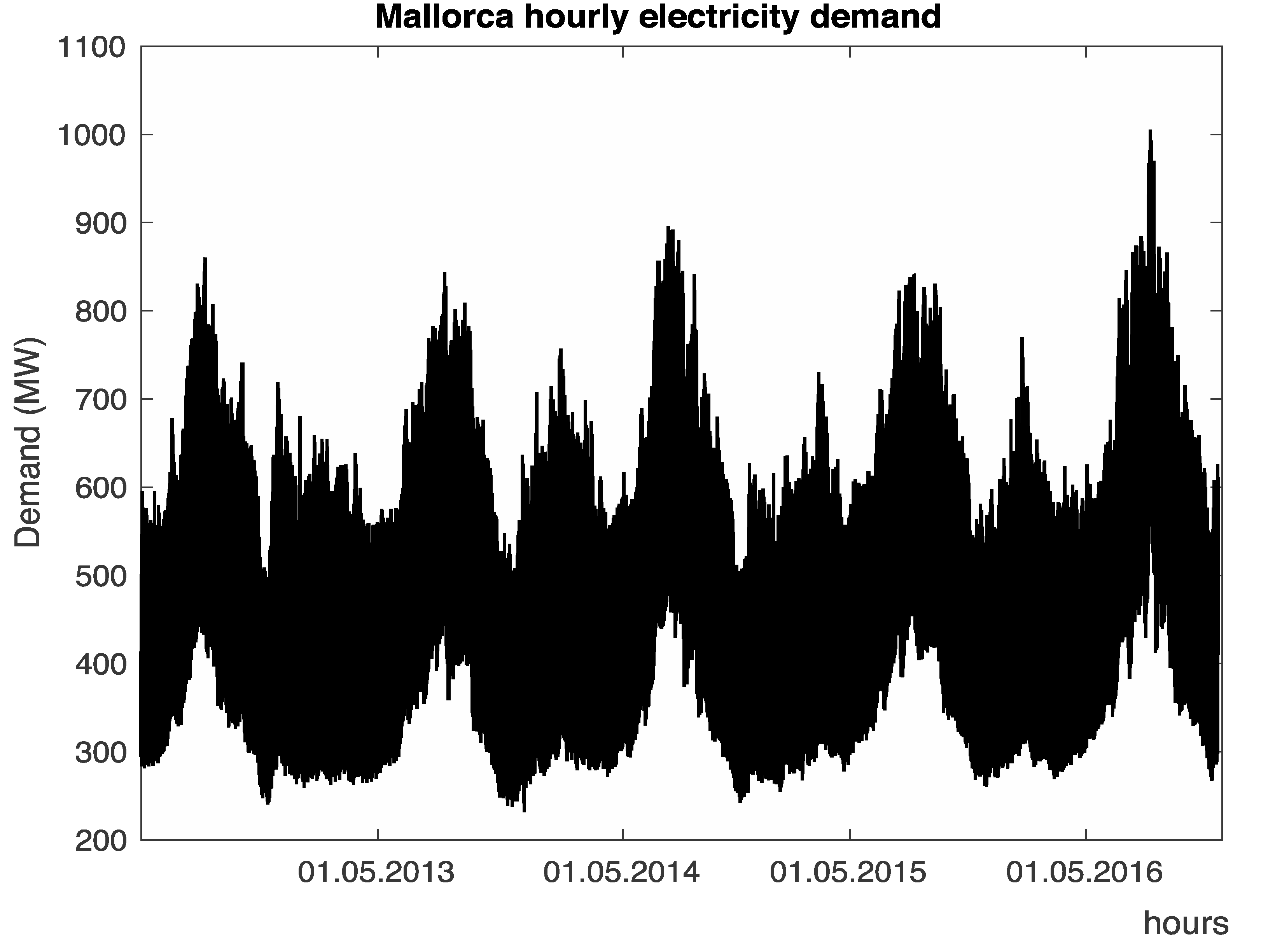
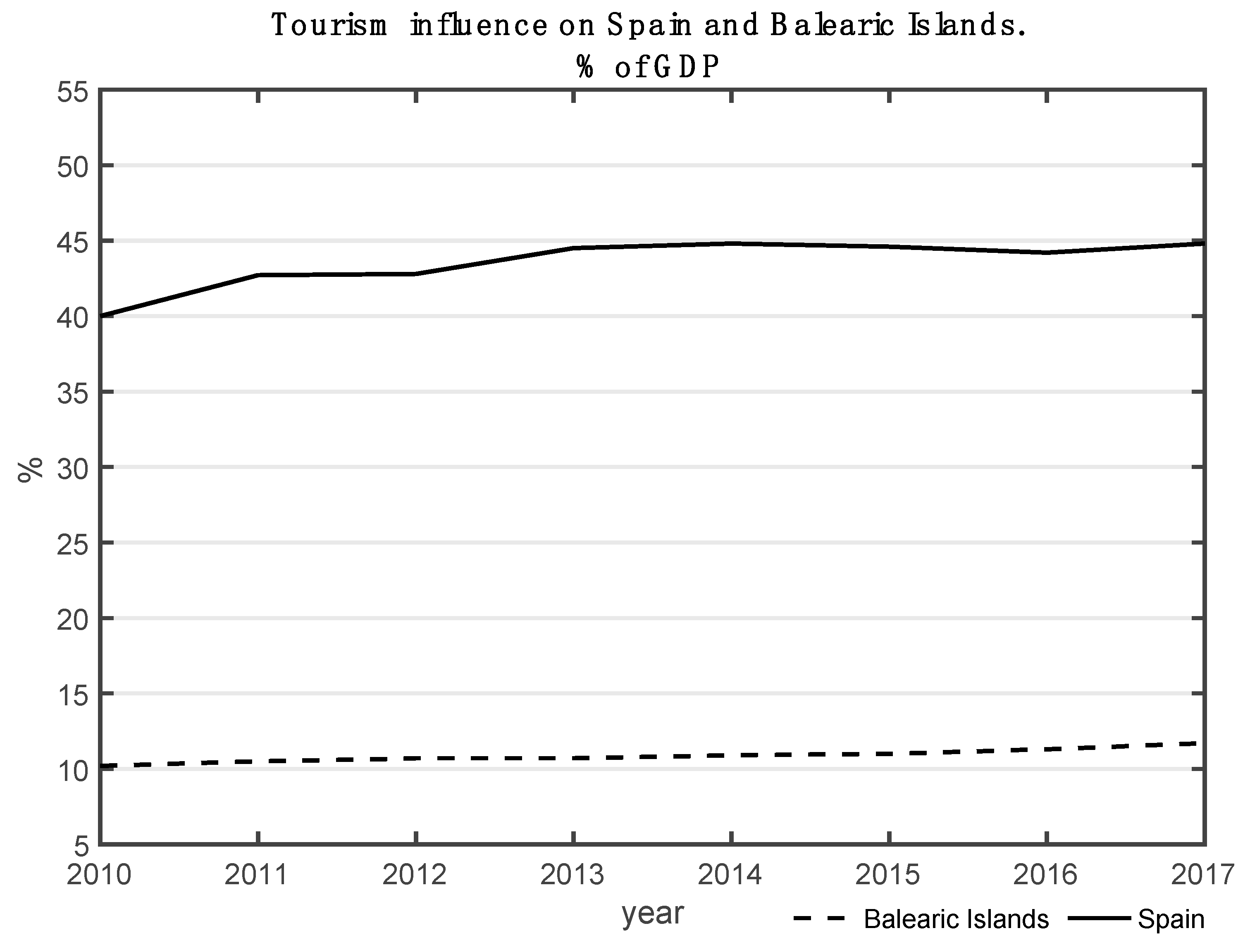
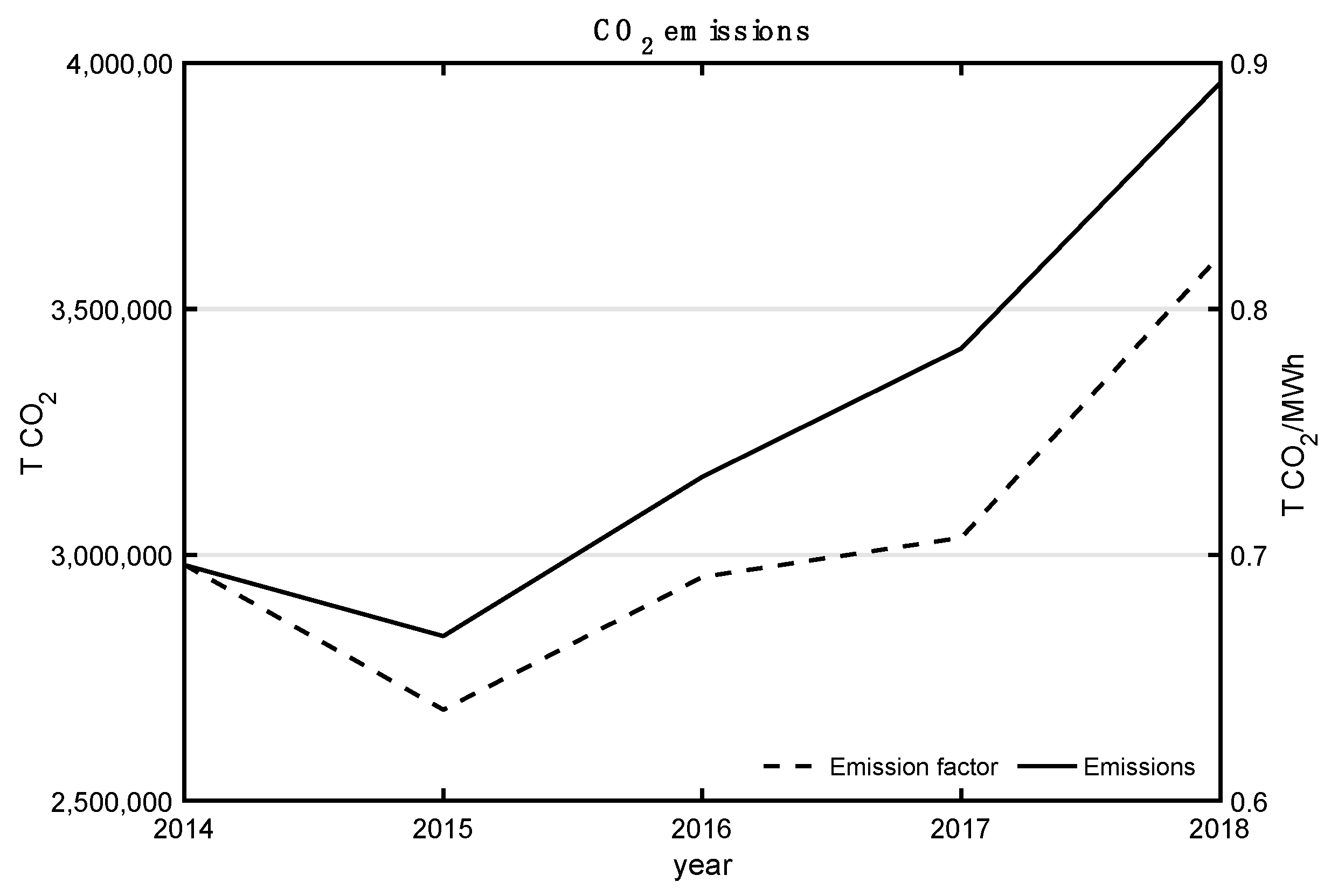
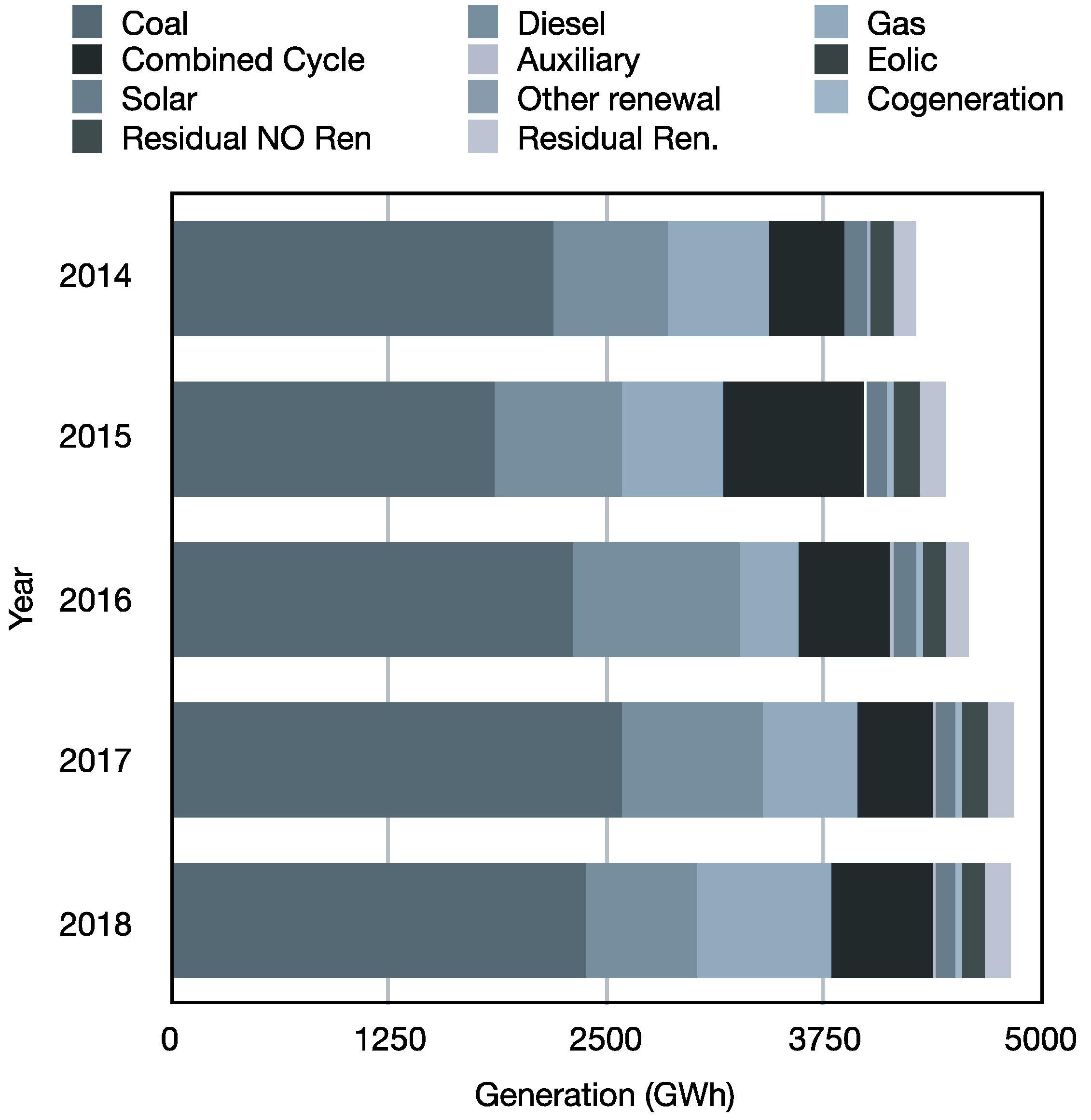
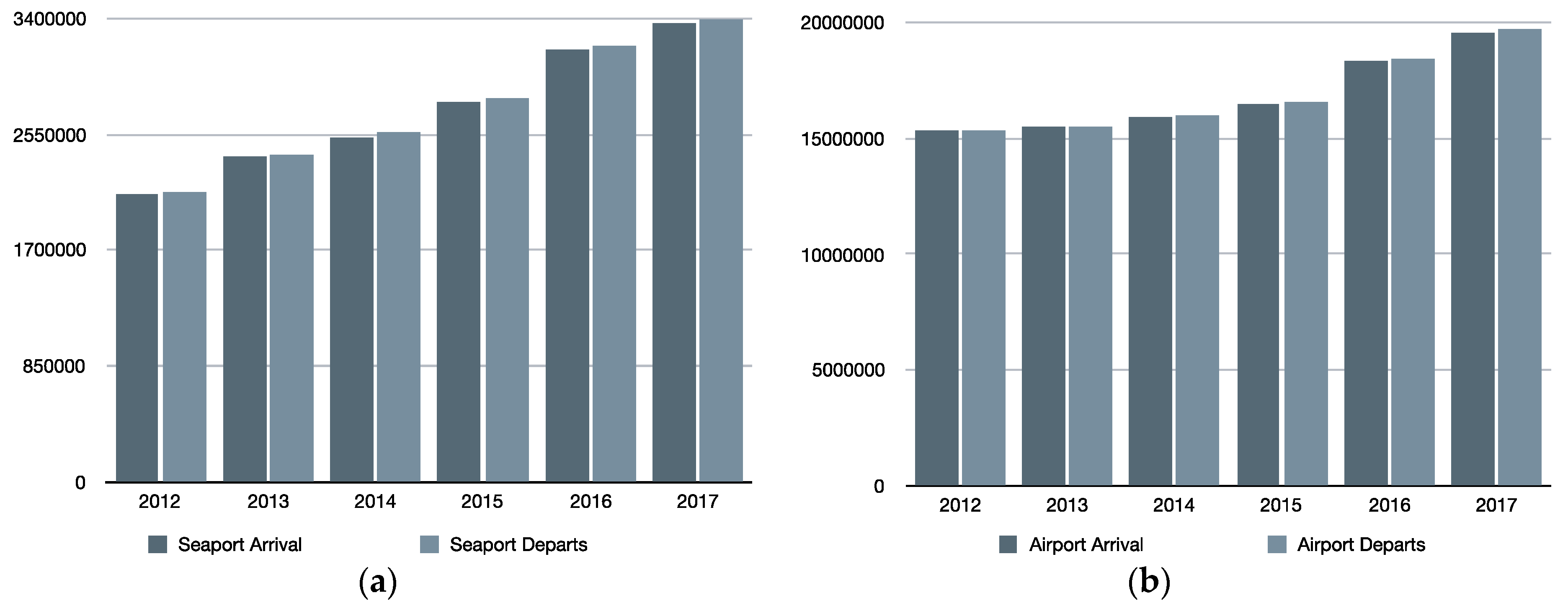


| Seasonality | None | Additive | Multip. | None | Additive | Multip. | |
|---|---|---|---|---|---|---|---|
| Trend | Normal | AR(1) Adjusted | |||||
| None | NNL | NAL | NML | NNC | NAC | NMC | |
| Additive | ANL | AAL | AML | ANC | AAC | AMC | |
| Damped Additive | dNL | dAL | dML | dNC | dAC | dMC | |
| Multiplicative | MNL | MAL | DML | MNC | MAC | MMC | |
| Damped Multiplicative | DNL | DML | DML | DMC | DAC | DMC | |
| Mallorca | Menorca | |||
|---|---|---|---|---|
| 2-STEP | ALL-IN-ONE | 2-STEP | ALL-IN-ONE | |
| AMC | −0.06 | −0.12 | −0.03 | −0.02 |
| AAC | −0.05 | −0.10 | −0.03 | −0.03 |
| NAC | −0.05 | −0.09 | −0.03 | −0.03 |
| NMC | −0.06 | −0.11 | −0.03 | −0.03 |
| Hour | AMC | AAC | NAC | NMC |
|---|---|---|---|---|
| 1 | 0.0 | 0.0 | 0.0 | 0.0 |
| 2 | −0.1 | 0.0 | 0.0 | 0.0 |
| 3 | 0.0 | 0.0 | 0.0 | 0.0 |
| 4 | 0.0 | 0.0 | 0.0 | 0.0 |
| 5 | 0.0 | 0.0 | 0.0 | 0.0 |
| 6 | 0.0 | 0.0 | 0.0 | 0.0 |
| 7 | −0.1 | −0.1 | −0.1 | −0.1 |
| 8 | −0.3 | −0.2 | −0.2 | −0.3 |
| 9 | −0.2 | −0.2 | −0.2 | −0.2 |
| 10 | −0.1 | −0.1 | −0.1 | −0.1 |
| 11 | −0.1 | −0.1 | −0.1 | −0.1 |
| 12 | −0.2 | −0.1 | −0.1 | −0.2 |
| 13 | −0.1 | −0.1 | −0.1 | −0.1 |
| 14 | −0.1 | −0.1 | −0.1 | −0.1 |
| 15 | −0.1 | −0.1 | −0.1 | −0.1 |
| 16 | −0.2 | −0.2 | −0.2 | −0.2 |
| 17 | −0.2 | −0.2 | −0.2 | −0.2 |
| 18 | −0.3 | −0.2 | −0.2 | −0.2 |
| 19 | −0.2 | −0.2 | −0.2 | −0.2 |
| 20 | −0.2 | −0.2 | −0.2 | −0.2 |
| 21 | −0.2 | −0.2 | −0.2 | −0.2 |
| 22 | −0.1 | −0.1 | −0.1 | −0.1 |
| 23 | 0.0 | 0.0 | 0.0 | 0.0 |
| 24 | −0.1 | −0.2 | 0.0 | 0.0 |
© 2019 by the authors. Licensee MDPI, Basel, Switzerland. This article is an open access article distributed under the terms and conditions of the Creative Commons Attribution (CC BY) license (http://creativecommons.org/licenses/by/4.0/).
Share and Cite
Trull, O.; Peiró-Signes, A.; García-Díaz, J.C. Electricity Forecasting Improvement in a Destination Using Tourism Indicators. Sustainability 2019, 11, 3656. https://doi.org/10.3390/su11133656
Trull O, Peiró-Signes A, García-Díaz JC. Electricity Forecasting Improvement in a Destination Using Tourism Indicators. Sustainability. 2019; 11(13):3656. https://doi.org/10.3390/su11133656
Chicago/Turabian StyleTrull, Oscar, Angel Peiró-Signes, and J. Carlos García-Díaz. 2019. "Electricity Forecasting Improvement in a Destination Using Tourism Indicators" Sustainability 11, no. 13: 3656. https://doi.org/10.3390/su11133656
APA StyleTrull, O., Peiró-Signes, A., & García-Díaz, J. C. (2019). Electricity Forecasting Improvement in a Destination Using Tourism Indicators. Sustainability, 11(13), 3656. https://doi.org/10.3390/su11133656






